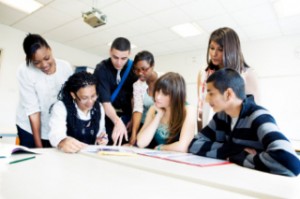I’ve written several posts explaining how and why I think people comprehension skills should be taught in the public education system. Developing these skills in elementary school and middle school allows students to have exposure to different types of conflict, foster a greater understanding of opposing viewpoints, and build basic negotiation skills. In high school, it’s time to continue developing those skills by applying them to real world scenarios.
skills. In high school, it’s time to continue developing those skills by applying them to real world scenarios.
With a more mature and exposed outlook on the world, high school students should be given the opportunity to practice their people comprehension skills while analyzing real world political, social, and historical conflicts. That way, they can really put their skills to the test and negotiate real issues that could have a much greater impact. Additionally, these “people comprehension lessons” don’t necessarily need to be given a specific time period in the students’ schedule (like I proposed for elementary and middle school students) – the exercises can be integrated into the lesson plans of specific classes that are relevant to applicable scenarios.
For example, one type of exercise that can be included in a history class is re-visiting a conflict at any point in time – like a war – and transforming the classroom into an imaginary setting of a peace or negotiation talk. Students will be placed into groups representing four perspectives: the two opponents, the mediator or facilitator, and a policy maker. The opposing groups will debate – with the help of the mediator, who can also ask each group questions – and explain each point of view to the policy maker, who will ultimately create a peace treaty that benefits both sides of the conflict. Students in each group will be forced to analyze the situation, understand the opposing viewpoints, and and work together – all while gaining experience resolving conflict nonviolently. This would also be a valuable exercise in a lesson plan that allows for greater knowledge of a historical conflict, as students would also leave with a much deeper understanding of the situation than if they simply read about it in a textbook.
This type of exercise can also be used to analyze current (or historical) political conflict. If students were learning about the differences between United States political parties, for example, this would be a great way to teach them each party’s point of view on particular issues. The set-up would be similar to the example above, with four groups of students representing four different perspectives on an issue, but instead of figuring out how to avoid war, they would determine compromises on the various social and political issues.
By the end of high school, students should have not only successfully developed their people comprehension skills so they can understand each other, but have also had experience in practicing those skills in real world scenarios. The truth is that there will always be differing opinions, clashing perspectives, and general conflict – but the best way to prevent it from escalating into violence and war is to be equipped with the skills to negotiate. Building people comprehension skills from kindergarten through 12th grade enables children to develop into open minded adults, and consequently closes the gap of understanding between points of view. Teaching these skills through the U.S. public education system – and therefore reaching the overwhelming majority of students – can create a society of greater understanding.
To learn more about my proposal for implementing people comprehension skills in the U.S. public education system, please check out part I, II, and III of the blog series and my webinar presentation titled “How to Teach Kids How to Understand Each Other.”
Rebecca Birnbaum is a Program and Research Intern with the SISGI Group focusing on nonviolent conflict resolution, nonprofit management, and sustainable development. She is a senior at the University of Michigan, where she studies Anthropology, Political Science, and Peace and Social Justice. To learn more about the SISGI Group, visit www.sisgigroup.org.

